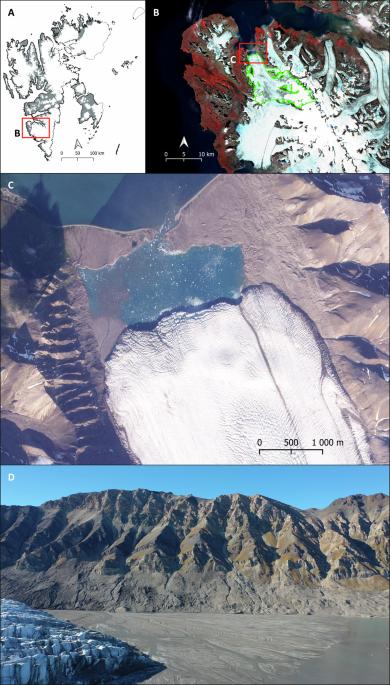Glacier surge as a trigger for the fastest delta growth in the Arctic
IF 8.1
1区 地球科学
Q1 ENVIRONMENTAL SCIENCES
引用次数: 0
Abstract
The widespread retreat of Svalbard glaciers has been frequently interrupted by short-lived surge advances. In the case of marine-terminating glaciers this is often expressed in the remodelling of coastal zones. Here, we analyzed the coastal zone changes in front of the recently surging Recherchebreen. The glacier advanced ca 1200 m since 2018 and suddenly stopped in June 2020 followed by the rapid formation of a delta system in front of its subglacial meltwater outlet. The delta advanced by ca 450 m with probably the fastest progradation rate ever detected in the Arctic region (ca 7 m/day). The synchroneity of the final slow-down of the glacier with the delta building indicates that this event records the release of stored water and sediments from beneath the glacier and thus provides direct evidence of drainage reorganisation at the termination of a surge. Such behaviour is likely common among Svalbard surging glaciers, but it only rarely leaves any direct geomorphic evidence. The Recherchebreen glacier in Svalbard, which had been advancing at 1200 m since 2018, abruptly stopped in June 2020, forming a rapid delta system with a daily progradation rate of 7 meters, suggesting drainage reorganization at the end of the surge, according to analysis of the changes in the coastal zone of the Recherchebreen glacier.

冰川激增是北极地区三角洲增长最快的导火索
斯瓦尔巴冰川的大面积后退经常被短暂的激增打断。在海洋末端冰川的情况下,这通常表现为海岸带的重塑。在这里,我们分析了最近涌动的 Recherchebreen 冰川前的海岸带变化。冰川自 2018 年以来前进了约 1200 米,2020 年 6 月突然停止前进,随后在其冰下融水出口前迅速形成了三角洲系统。三角洲前进了约 450 米,其前进速度可能是在北极地区探测到的最快的(约 7 米/天)。冰川最终减速与三角洲形成的同步性表明,这一事件记录了冰川下储存的水和沉积物的释放,从而提供了暴涨结束时排水系统重组的直接证据。这种行为在斯瓦尔巴冰川涌动中可能很常见,但很少留下直接的地貌证据。根据对 Recherchebreen 冰川沿岸带变化的分析,位于斯瓦尔巴群岛的 Recherchebreen 冰川自 2018 年以来一直以 1200 米的速度向前推进,2020 年 6 月突然停止,形成了一个快速三角洲系统,日推进速度达 7 米,表明在涌流结束时发生了排水重组。
本文章由计算机程序翻译,如有差异,请以英文原文为准。
求助全文
约1分钟内获得全文
求助全文
来源期刊

Communications Earth & Environment
Earth and Planetary Sciences-General Earth and Planetary Sciences
CiteScore
8.60
自引率
2.50%
发文量
269
审稿时长
26 weeks
期刊介绍:
Communications Earth & Environment is an open access journal from Nature Portfolio publishing high-quality research, reviews and commentary in all areas of the Earth, environmental and planetary sciences. Research papers published by the journal represent significant advances that bring new insight to a specialized area in Earth science, planetary science or environmental science.
Communications Earth & Environment has a 2-year impact factor of 7.9 (2022 Journal Citation Reports®). Articles published in the journal in 2022 were downloaded 1,412,858 times. Median time from submission to the first editorial decision is 8 days.
 求助内容:
求助内容: 应助结果提醒方式:
应助结果提醒方式:


